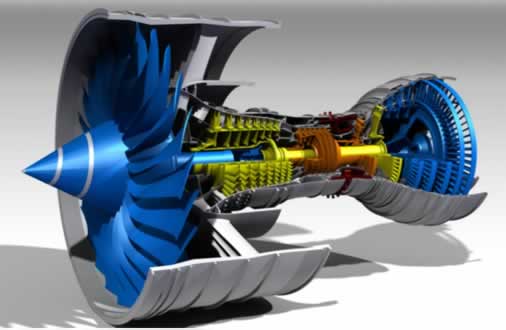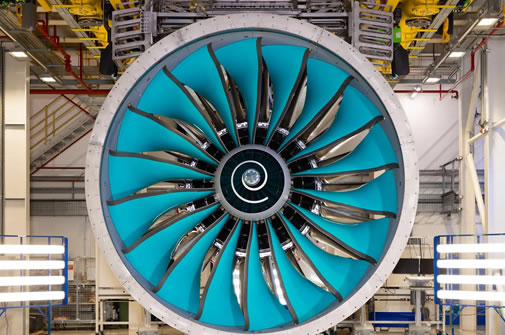航空发动机涡轮叶片生产工艺/Aircraft engine turbine blade production technology
Editor's note: The production of aeroengine turbine blades is called the top mechanical manufacturing, it is one of the most important parts of aeroengine, the use of materials different from ordinary materials, the price is very expensive. The performance of the engine is largely determined by the level of design and manufacture of the blade profile. The following mainly shows the processing process, testing process and casting molding process of aero engine turbine blades.
1, blade processing
Blade is a typical free-form surface parts, processing such parts have a feature: thin, easy to deform when processing, and the material is usually stainless steel, monel alloy, INCONEL, titanium and nickel based on difficult to process alloy materials, but also increase the difficulty of processing, while the processing technology and processing tools put forward higher requirements.
German INDEX processing aviation turbine blades:
In the blade processing, the blade processing difficulties have the following three aspects: milling process, blade root processing, milling and stretching holes.

2. Blade detection
For aircraft, the normal operation of the engine is the most important one, and to ensure the safe operation of the engine, the quality of the blade must pass strict testing! Blade detection is mainly size and shape detection, as well as crack detection.
(1)Size and shape detection
There are many blades on an engine, about 30 blades on each disk, if the shape and size of the blade can not be guaranteed, then it is very dangerous when the engine is running at high speed. Therefore, the detection of blade profile and geometric size is also very important, but the conventional measurement method is difficult to measure the shape of the blade, so scientists have developed a coordinate measurement system, through the establishment of measurement data to establish a model to judge the difference between blade profile and size.
(2)Crack detection
Cracks are the most fatal defects of engine blades. The working conditions of the aero engine blade are very bad, resulting in the blade often subjected to impact, friction, while also enduring high temperature burning and hot and cold fatigue, the blade is prone to produce a variety of cracks, if not found and treated in time, it will bring great threats to the safety of aircraft flight, so the use of effective methods to find cracks in the blade has been the pursuit of scientists.
At present, the commonly used detection methods include CTI technology, TOFD technology, infrared technology, UT technology and so on.
Automatic turbine blade detection system:
3, casting process
Here is a brief description of how to make turbine blades for aeroengines:
Process China clay, break it up, and make the inner core of turbine blades.
The workers will check the shape of the molded porcelain clay model one by one, and the finished porcelain clay model will first be burned into a fused quartz ceramic core.
Turbojet engines need hollow turbine blades, and only high-quality ceramic cores are the best inner core materials for lost wax casting, which can remain stable when casting metal, and can be easily dissolved by chemical processes after the casting is cooled, leaving the required air passage in the blades.
The porcelain clay model waiting for processing is coated with beeswax and cast by lost-wax method to obtain turbine blades. Porcelain clay models can be made with very small cross sections and with little deformation during processing.
The China clay model is actually an air channel in the blades, which allows air to pass through while the engine is running, thereby cooling the turbine blades and keeping them working steadily.
Prepare the casting interface. These interfaces will be fitted with two to four blades, which will increase efficiency when casting molten metal.
In coating the ceramic core with beeswax, the role of beeswax is to form cavities in the casting mold.
After the beeswax leaves are installed on the casting interface, it can be seen that the beeswax leaves that have been wrapped with a ceramic core look robust, but they are all metal flow channels when casting, and the leaves are actually very small.
The blade is finished so that the molten metal can fill the cavity without creating casting sand holes.
At this point, the cast model is finally machined.
The next step is to wrap the cast models in China clay to make pottery. Workers mount the cast model on a rotating machine. The manipulator is rotated in the clay solution so that it evenly covers all parts of the model. That's how you qualify. It is then added to a special bellows and sprayed with China clay to form a thick shell. Air dry.
The cast model is then cast in a precision casting workshop.
First of all, the heat is heated, and the porcelain clay wrapped around the casting model is fired into a ceramic mold. At the same time, the inner beeswax is discharged to form a casting cavity. The worker took out the casting mold. These molds will then be cast with a special alloy solution. Each mold is processed in a special furnace. The mold production temperature of large parts is very high.
Finally, the produced blades need to be X-rayed. Each blade should be inspected from multiple angles to prevent any defects. X-rays show the cavities inside the blades.
The whole turbine blade production process is very complicated, completely beyond the jewelry manufacturing industry, and this is only a small part of the "diamond in the industrial crown" - aviation engine manufacturing.
The complete blade design and manufacturing includes: blade structure design, blade strength design, blade material design, blade manufacturing process design. Failure mode analysis of blade in use. What we have shown today is only a small part of it.
From the development history of aero engine turbine blades, the trend of integration of materials, technology and design is becoming more and more obvious. Engine design is from a low level to a high level of development, the blade material design is the same, the design stage is different, the design requirements are different, the design method is different, the material and the manufacturing process is not the same.
Brazing (Cnbraze) platform has gathered resources, now comb the resources, so that brazing friends to pay attention to empower, we will provide you with the following services.
1. Filler metal
Bringing together the world's most complete brazing materials, there are more than 2000 kinds of brazing materials.
The world's most advanced brazing material.
According to the base material, heating method, working temperature, other related requirements, brazing material selection.
Can provide gold base, silver base, copper base, palladium base, nickel base, aluminum base and other brazing materials.
Related industries: refrigeration, air conditioning, electronics, automotive industry, aerospace, cutting tools, bullet trains, hydraulic pipelines, medical and other industries.
The above brazing materials involve industries: refrigeration, air conditioning, electronics, automotive industry, aerospace, cutting tools, bullet trains, hydraulic pipelines, medical and other industries.
2. Equipment
A. Induction brazing equipment (foreign, domestic), for your selection, to provide technical services.
B. Vacuum brazing furnace, for your selection, provide technical services.
C. Atmosphere furnace, continuous furnace, type selection for you, provide technical services.
D. Used vacuum brazing furnace
F. Release of bidding information for brazing equipment
3. Process plan
A. There are industry experts to give you the most professional solutions.
B. Solutions for process improvement and quality improvement
C. Brazing process plan
4. Precise product solutions
Subdivision of the industry, the full range of specific products
Scheme:
A. Vacuum brazing diamond wheel tool
B. Vacuum brazing diamond (single crystal, CBN, PCD) tool,
C. Automatic induction brazing production line
D. Aluminum alloy sandwich honeycomb structure of continuous furnace
E. Battery aluminum cover plate, aluminum brazing
F. Vacuum brazing of non-metals and metals (ceramics, diamond, carbide, carbon carbon, silicon carbide composites and metal brazing)
Complete solution from process, equipment, solder.
G. Brazing of plate fin EGR cooler, shell and tube EGR cooler, stainless steel oil cooler
F. Induction brazing woodworking tools, vacuum brazing woodworking tools
H. Mobile phone VC soaking plate, electronics, computer copper alloy radiator brazing program
I. Water-cooled plate, liquid-cooled plate aluminum brazing program
J.cd oil drill bits, brazing solutions for PCD bearings
And so on... .
5. Brazing processing business
A. Sample of brazed products
B. Brazing parts processing (Beijing, Xi 'an, Hangzhou, Nanjing, Qingdao and other enterprises cooperation foundry)
6. Cooperate with universities and research institutes
Cnbraze platform has cooperated with Harbin Institute of Technology, Shandong University, Tianjin University, Northwestern Polytechnical University, Jiangsu University of Science and Technology, Shandong University of Science and Technology, Beijing, Shanghai, Lanzhou Chinese Academy of Sciences and other institutions, will continue to provide you with brazing process solutions, brazing equipment consulting, the most advanced brazing materials.
编者语:航空发动机涡轮叶片的生产称得上顶级机械制造,它是航空发动机最重要的零件之一,采用的材料不同于普通材料,价格非常昂贵。发动机的性能很大程度上取决于叶片型面的设计和制造水平。下面主要展示航空发动机涡轮叶片的加工过程、检测过程和铸造成型工艺。
1,叶片加工
叶片是一类典型的自由曲面零件,加工这类零件时都有一个特点:薄,加工时易变形,并且材质通常为不锈钢、蒙乃尔合金、INCONEL、钛和镍为基础的难加工合金材料,更增添了加工的困难度,同时对加工工艺与加工用的刀具提出了更高的要求。
德国INDEX加工航空涡轮叶片:
在叶片的加工中,叶片加工难点有以下3个方面:铣工艺围带处,叶根的加工,铣拉筋孔。

2,叶片检测
对于飞机来说,发动机的正常运转是最为重要的一条,而要保证发动机安全运转,叶片的质量就必须通过严格的检测!叶片检测主要是尺寸和形状检测,以及裂纹检测。
1)尺寸和形状检测
一个发动机上有很多叶片,每一个圆盘上大概有30多个叶片,如果叶片的形状和尺寸不能够保证,那么在发动机高速运转时是非常危险的。所以对于叶片的型面和几何尺寸检测也是非常重要的,但是就叶片的形状来说常规测量方法很难进行测量,所以科学家研究出了一种三坐标测量系统,通过建立测量数据来建立模型从而判断叶片的型面和尺寸的差异。
2)裂纹检测
裂纹是发动机机叶片最致命的缺陷。而航空发动机叶片的工作条件非常恶劣,致使叶片经常受到冲击、摩擦,同时还忍受着高温的灼烧和冷热疲劳,叶片容易产生各种各样的裂纹,如果不能及时发现并处理,会对飞机飞行安全带来极大的威胁,所以采用有效的方法来发现叶片中的裂纹一直是科学家们追求的。
目前,常用检测方法有CTI技术、TOFD技术、红外技术、UT技术等。
涡轮叶片自动检测系统:
3,铸造工艺
下面我们简述一下如何制造航空发动机的涡轮叶片:
加工瓷土,将瓷土打碎,制作涡轮叶片的内芯。
工人将塑形后的瓷土模型逐个检查修形,做好的瓷土模型将首先烧结成熔融石英陶瓷芯。
涡轮喷气式发动机需要中空的涡轮叶片,只有高质量的陶瓷芯是失蜡法铸造的最好内芯材料,它能够在浇铸金属时依然能够保持稳定,在铸件冷却后有能通过化学工艺轻易溶解,在叶片中留下所需要的空气通道。
等待进行加工的瓷土模型在外部包裹蜂蜡进行失蜡法铸造,从而得到涡轮叶片。瓷土模型可以制作成横截面非常小,而且在加工过程中变形小。
上述瓷土模型其实就是叶片中的空气通道,在发动机运转时,有空气在其中通过,从而冷却涡轮叶片保持工作稳定。
准备浇铸接口。这些接口将安装二到四个叶片,这样浇铸熔融金属时可以提高效率。
在给陶瓷芯包裹蜂蜡,蜂蜡的作用是在铸造范摸中形成空腔。
将蜂蜡叶片安装到浇铸接口上后可以看到,已经包裹了陶瓷芯的蜂蜡叶片看起来结构粗壮,但都是浇铸时的金属流道,叶片其实非常细小。
将叶片进行最后加工,这样熔融金属就可以将空腔充满,不会造成铸造砂眼。
到此,铸造模型终于被加工好。
下一步是将这些铸造模型包裹瓷土,制作陶范。工人将铸造模型安装的一个旋转机械上。用机械手在陶土液中旋转,使其均匀包裹住模型的任何部位。这样才能算合格。之后加入特殊风箱中,在外表喷淋瓷土,形成厚实的外壳。进行风干。
之后,铸造模型在精密铸造车间进行浇铸。
首先要进行加温,将铸造模型外部包裹的瓷土烧成陶瓷范模。同时,将内部的蜂蜡排出,形成铸造空腔。工人取出铸造范模。然后这些范模将浇铸特殊合金溶液。每种范模都要一种特别的熔炉进行加工。大型部件的范模生产温度非常高。
最后,生产出的叶片还需要进行X光探伤。每个叶片都要进行多角度探伤,防止出现任何瑕疵。X光照片,可以看出叶片内部的空腔。
整个涡轮叶片生产工艺非常繁复,完全超越了珠宝制造工业,而这仅仅是“工业皇冠上的钻石”――航空发动机制造的一小部分。
完整的叶片设计制造包括:叶片结构设计,叶片强度设计,叶片材料设计,叶片制造工艺设计。叶片使用过程中的故障模式分析等。咱们今天展示的内容只是很少的一部分。
从航空发动机涡轮叶片的发展历程来看,材料、工艺与设计一体化的趋势越加明显。发动机设计是由低水平向高水平发展,叶片材料设计也是如此,设计阶段不同,设计要求不同,设计方法不同,采用的材料和制造工艺也不相同。
钎焊(Cnbraze)平台已汇集各方资源,现梳理各项资源,让关注钎焊的钎友们赋能,我们将为您提供的以下服务。
1.钎料
汇集全球最全钎焊材料,已有超过2000种钎焊材料。
全球最先进的钎焊材料。
根据母材,加热方式,工作温度,其他相关要求,进行钎焊材料的选型。
可提供金基,银基,铜基,钯基,镍基,铝基等钎焊材料。
涉及行业:制冷,空调,电子,汽车行业,航空航天,刀具,动车,液压管路,医疗等行业。
以上的钎焊材料涉及行业:制冷,空调,电子,汽车行业,航空航天,刀具,动车,液压管路,医疗等行业。
2.设备
A.感应钎焊设备(国外,国内),为你选型,提供技术服务。
B.真空钎焊炉,为你选型,提供技术服务。
C.气氛炉,连续炉,为你选型,提供技术服务。
D.二手真空钎焊炉
F.钎焊设备招标信息发布
3.工艺方案
A.有行业专家给你最专业的方案。
B.工艺改善,质量提升的解决方案
C.钎焊工艺方案
4.精准产品解决方案
细分行业,具体产品的全套方案
方案:
A.真空钎焊金刚石砂轮工具
B.真空钎焊钻石(单晶,CBN,PCD)刀具,
C.截齿自动感应钎焊生产线
D.连续炉的铝合金三明治蜂窝结构
E.电池铝盖板,铝钎焊
F.真空钎焊非金属与金属(陶瓷,金刚石,硬质合金,碳碳,碳化硅复合材料与金属钎焊)
从工艺,设备,钎料的全套解决方案。
G.板翅式EGR冷却器,壳管式EGR冷却器,不锈钢油冷器的钎焊
F.感应钎焊木工刀具,真空钎焊木工刀具
H.手机VC均热板,电子,电脑的铜合金散热器钎焊方案
I.水冷板,液冷板铝钎焊方案
J.PCD石油钻头,PCD轴承的钎焊方案
等等…….
5.钎焊代加工业务
A.钎焊产品的试样
B.钎焊部件的代加工(北京,西安,杭州,南京,青岛等多家企业合作代工)
6.与院校,科研院所合作
钎焊(Cnbraze)平台,已与哈工大,山东大学,天津大学,西北工业大学,江苏科技大学,山东科技大学,北京,上海,兰州的中国科学院等多家院所合作,会一如既往的为您提供钎焊工艺解决方案,钎焊设备咨询,最先进的钎焊材料。
版权说明:
1,全面、新鲜的航材资讯及交易概况发布
2,图片及内容涉及侵权,联系微信
3,转载或者引用本文内容请注明来源及原作者;
4,专注二手波音、空客、二手航材等相关领域




